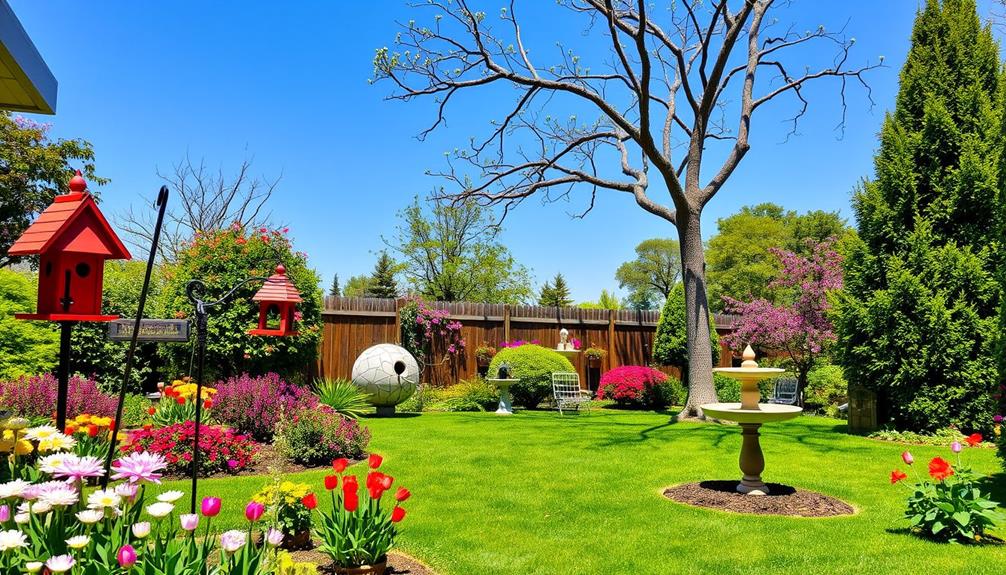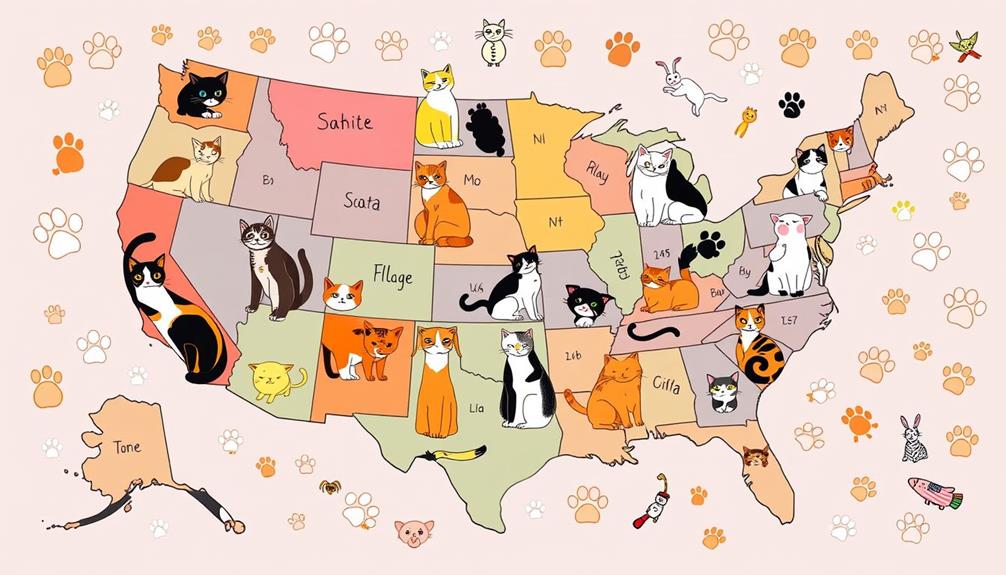To set up a backyard bird sanctuary, start by researching local bird species to understand their needs. Choose a mix of native plants that provide food and shelter, enhancing the habitat's diversity. Install bird feeders filled with suitable seeds, and guarantee access to fresh water through bird baths or fountains. Create safe nesting areas using well-designed birdhouses, and keep your space clean to prevent illness. Stay vigilant against invasive species that can harm native plants. By cultivating a bird-friendly environment, you'll invite a variety of species and enjoy the beauty of nature right outside your door. There's much more you can explore!
Key Takeaways
- Research local bird species to understand their dietary needs and seasonal habits for effective feeding and habitat setup.
- Choose native plants that provide food and nesting opportunities, ensuring a diverse and balanced habitat.
- Set up bird feeders with appropriate seed types, maintaining regular cleaning and refilling to attract various birds.
- Provide reliable water sources like bird baths or fountains, changing the water frequently to prevent stagnation.
- Monitor and remove invasive species to protect native plants and maintain a healthy ecosystem for local wildlife.
Benefits of a Bird Sanctuary
Creating a bird sanctuary not only beautifies your backyard but also offers numerous ecological and personal benefits. By establishing a space dedicated to bird conservation, you play an essential role in enhancing your local environment.
Birds act as natural pest controllers, greatly reducing harmful insect populations. This reduction helps promote a healthier ecosystem, benefiting all species, including you. Additionally, a diverse bird population can contribute to a more vibrant atmosphere in your yard, much like how dog breeds and care can enrich a household with joy and companionship.
Your sanctuary can support local plant growth through bird-assisted pollination, contributing to a robust and diverse ecosystem. As you watch the birds flourish, you'll likely notice improvements in your own mental well-being. Engaging with nature through birdwatching and sanctuary activities fosters emotional health and reduces stress.
Participating in community-driven events, like the Great Backyard Bird Count, not only enhances your experience but also strengthens local engagement in conservation efforts. By creating a bird sanctuary, you increase local biodiversity, ensuring a balanced ecosystem that supports various species.
Ultimately, your efforts will lead to a thriving environment, showcasing the interconnectedness of nature and personal wellness. So, take the plunge and enjoy the myriad benefits that come with creating your own bird sanctuary!
Research Local Bird Species
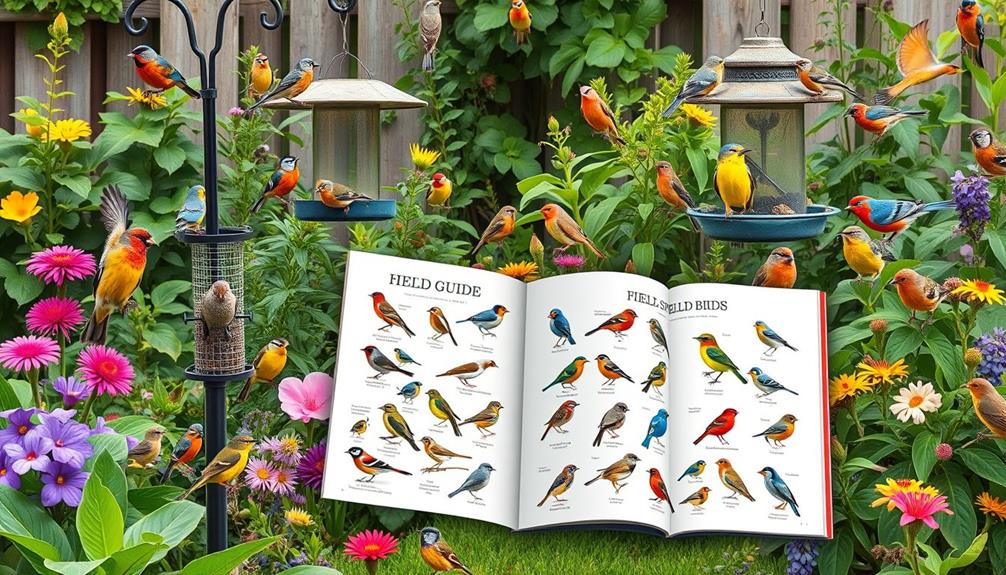
To maximize the benefits of your bird sanctuary, it's important to research the local bird species that frequent your area. Start by using field guides, birding apps, or websites like the Audubon Society to identify which birds you can expect. Understanding their dietary preferences will help you choose the right food and native plants to attract them.
Additionally, pay attention to seasonal migration patterns. Knowing when certain species arrive will allow you to adjust your feeding and habitat offerings accordingly. Engaging with local birdwatching groups can provide valuable insights into the specific birds in your community and their conservation needs.
Here's a simple table to help you visualize some common local bird species:
| Bird Species | Food Preferences | Native Plants |
|---|---|---|
| American Goldfinch | Sunflower seeds | Coneflower, Asters |
| Red-bellied Woodpecker | Nuts, fruits | Oak, Maple |
| Eastern Bluebird | Insects, berries | Blueberry, Dogwood |
Researching local bird species not only enhances your sanctuary's effectiveness but also fosters a deeper connection to your environment. By creating a welcoming habitat, you're contributing to the well-being of these beautiful creatures.
Choosing the Right Plants
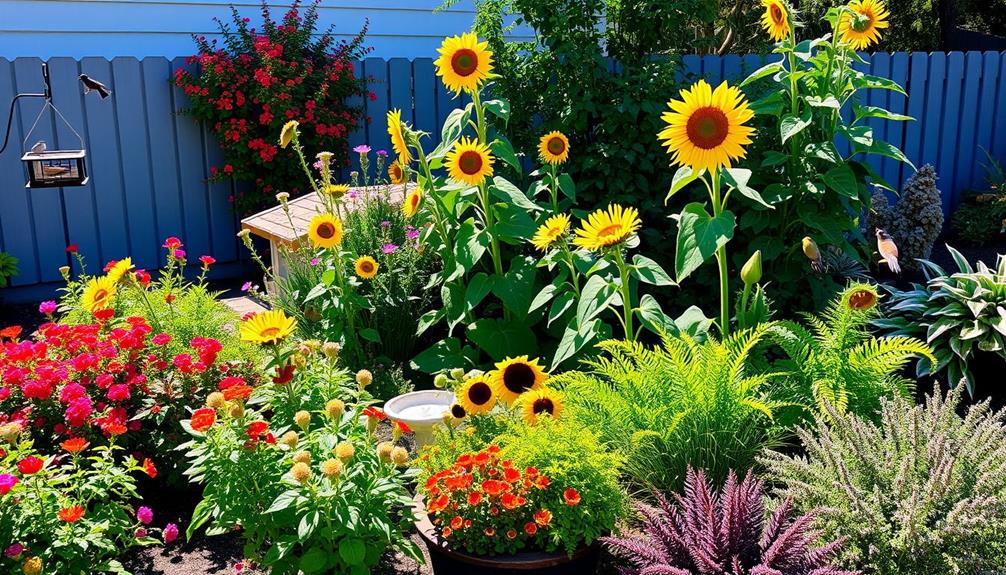
When choosing plants for your backyard bird sanctuary, focus on native species that thrive in your area. This not only creates a diverse habitat but also guarantees a steady food supply throughout the seasons.
Incorporating a variety of plants can enhance the ecological balance in your garden, similar to how ancient Hopi villages were designed to support their communities. By incorporating a mix of plant types and strategically planting for different times of the year, you can attract a wider variety of birds to your space.
Native Plant Selection
Selecting the right native plants for your backyard sanctuary not only fosters a vibrant ecosystem but also plays an important role in supporting local bird populations. By incorporating plants that are native to your region, you can create a habitat that mimics the natural landscapes birds rely on, which can be particularly beneficial for species that have adapted to specific environments.
Start by choosing native plants that thrive in your local climate. This enhances biodiversity and attracts beneficial insects and pollinators, which are vital for a healthy environment.
Incorporate a mix of flowering plants, shrubs, and trees to provide necessary food sources and nesting habitats for various bird species throughout the year. Aim for plants that bloom at different times to guarantee a continuous food supply, particularly during critical periods like spring migration and summer breeding.
Additionally, consider how these plants can complement your overall space, much like the space optimization found in tiny homes, making certain that every aspect of your sanctuary contributes to its purpose.
Make certain to remove invasive species and replace them with native alternatives. This will improve habitat quality, allowing better sunlight penetration and nutrient availability for the plants you choose.
Habitat Diversity Importance
Creating a diverse habitat in your backyard is vital for attracting a wider range of bird species and beneficial insects. Incorporating a variety of native plants enhances habitat diversity, providing the food and shelter that many birds and insects rely on. Long-blooming native species guarantee a continuous food source, essential for the survival and reproduction of these creatures throughout the seasons.
Additionally, maintaining a balanced ecosystem can support local wildlife populations more effectively, similar to how gout management strategies emphasize dietary diversity for health.
When you cluster native plants together, you create more effective habitats that draw in birds and beneficial insects alike. This not only boosts the ecological function of your yard but also enhances its aesthetic appeal.
Maintaining a mix of plant heights and structures—like shrubs, small trees, and ground cover—offers important nesting and foraging opportunities for various bird species.
Don't forget to remove invasive plant species and replace them with native alternatives. This simple action greatly improves habitat quality, leading to healthier ecosystems that support local wildlife populations.
Seasonal Planting Strategies
A well-planned selection of plants can transform your backyard into a seasonal haven for birds. By choosing native plants that bloom in different seasons, you guarantee a continuous food supply throughout the year, which supports birds' dietary needs during nesting and migration.
Incorporating essential knowledge for herbalism can help you understand the various plant properties and their benefits for local wildlife. Start with early season flowering plants like crocuses and willows; these are vital for hatchlings and migrating birds, providing essential food when resources are scarce.
Incorporate long-blooming plants, such as coneflowers and black-eyed Susans, as they offer nectar and seeds that attract diverse bird species.
Don't forget to mix in a variety of shrubs, trees, and flowering plants to create layered habitats, catering to different birds' nesting and feeding preferences.
Regularly evaluate your garden's plant diversity and replace invasive species with native alternatives. This enhances habitat quality and supports local wildlife populations.
By being intentional about your plant choices, you'll create an inviting environment for birds, guaranteeing they've the food sources they need throughout the seasons.
With some planning and care, your backyard can thrive as a bird sanctuary year-round.
Setting Up Bird Feeders

Setting up bird feeders in your backyard is a great way to attract a variety of feathered friends. By providing a consistent food source, you not only support local wildlife but also create an opportunity for children to engage in healthy outdoor play, fostering curiosity about nature and wildlife.
You'll want to choose the right feeder type and bird food to guarantee you're catering to the species you hope to see. Regular maintenance of your feeders is vital for keeping the birds healthy and happy.
Choosing Appropriate Feeders
How do you choose the right feeders for your backyard bird sanctuary? Start by selecting feeders based on the bird species you want to attract. For instance, finch socks are perfect for attracting finches, while tube feeders work well for chickadees and nuthatches. Each type of feeder has specific designs that cater to different birds, so choose wisely.
Additionally, consider incorporating features that promote sustainability, similar to eco-friendly energy sources that benefit the environment.
Next, make certain that the seed size matches the feeder hole dimensions. This prevents waste and allows birds to access the food easily. Fresh seeds are essential, as stale food can deter birds from visiting your feeders.
Regularly refill your feeders to maintain a consistent food supply, especially during peak feeding times in the morning and late afternoon.
Consider using platform feeders, as they offer versatility and can accommodate multiple types of food. This way, you'll attract a wider variety of birds.
Selecting Bird Food
Attracting birds to your backyard sanctuary hinges on selecting the right food. Start by choosing bird feeders that cater to the preferences of local species. For instance, tube feeders are ideal for chickadees and nuthatches, while thistle feeders attract finches.
It's vital to use fresh seeds that match the feeder type; Nyjer seeds work best in thistle feeders, whereas mixed seeds are perfect for hopper feeders. Additionally, guaranteeing that your backyard environment is safe and welcoming can also play a significant role in attracting birds, as they seek out habitats that provide both food and shelter.
Regularly providing mental health support for caregivers can enhance the joy of birdwatching, making the experience more fulfilling.
Pay attention to the seed size and verify it fits the feeder hole dimensions. This prevents waste and allows easy access for backyard birds. Regularly refilling your feeders is essential, particularly during winter when natural food sources dwindle. Consistency in food supply keeps your feathered friends returning.
Lastly, don't forget to clean your feeders regularly. This helps prevent the spread of disease among birds and keeps the food fresh and appealing.
Maintaining Feeders Regularly
While creating a vibrant bird sanctuary in your backyard, maintaining your feeders regularly is crucial for keeping your feathered visitors healthy and happy.
Proper care for your bird feeders can also reflect your personal growth and commitment to nurturing wildlife, similar to how emotional maturity influences relationships, including those with ex-partners personal growth and its impact on ex-relationships.
Clean your feeders every two weeks to prevent mold and diseases that can harm birds. Use a mixture of warm water and mild soap for cleaning, rinsing thoroughly to eliminate any soap residue before refilling with fresh seed.
Check and refill your feeders at least once a week, or more frequently during peak feeding times. This guarantees a consistent food supply for your visiting birds.
Additionally, inspect your feeders for damage and replace any worn or broken parts to maintain functionality and prevent injuries.
To make the most of your bird-feeding experience, consider these tips:
- Position feeders in safe, sheltered areas away from predators.
- Confirm feeders are accessible for easy maintenance.
- Store extra food indoors to keep it dry and fresh.
- Choose feeders that are easy to clean and refill.
- Monitor local bird activity to adjust feeding strategies.
Providing Water Sources
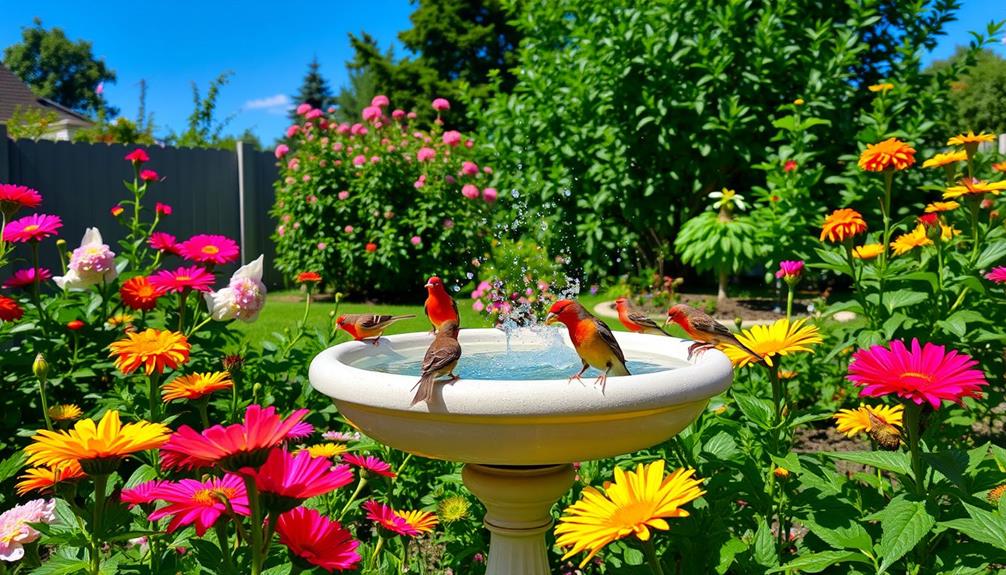
A well-placed bird bath can transform your backyard into a vibrant haven for feathered friends. By providing water sources, you create a reliable spot for birds to stay hydrated and bathe. Regularly changing the water every few days is essential; it prevents stagnation and guarantees a clean drinking supply.
Consider adding a fountain to your setup. Moving water is particularly attractive to birds and adds a dynamic touch to your sanctuary. To help you visualize, here's a quick comparison of different water sources:
| Water Source | Benefits |
|---|---|
| Bird Bath | Reliable hydration and bathing area |
| Fountain | Moving water attracts more species |
| Shallow Dish/Pond | Diverse options for various bird types |
Positioning these water sources near feeding areas increases their visibility and accessibility. You'll see more frequent visits as birds discover these invigorating spots. Don't forget to incorporate shallow dishes or ponds to cater to different species' drinking preferences. With these steps, your backyard will become a popular stop for local wildlife!
Maintaining a Clean Environment
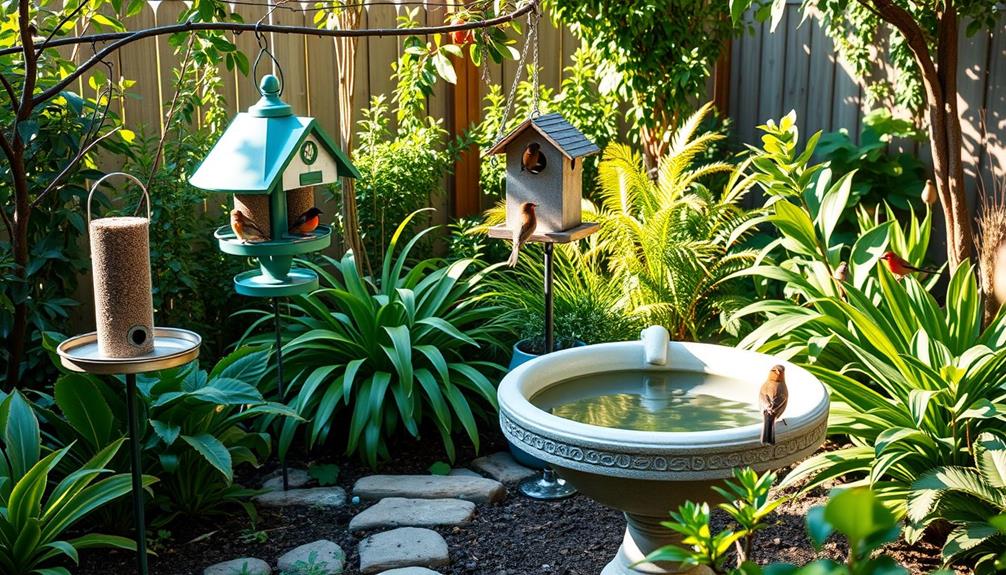
Maintaining a clean environment is crucial for the health and well-being of your backyard birds. To create a safe haven, you need to prioritize cleanliness around your feeders, baths, and nesting boxes. Regularly cleaning these areas not only helps prevent disease but also attracts a variety of birds, enhancing your birdwatching experience.
Here are some key practices to follow:
- Clean bird feeders at least once a week to prevent mold and disease.
- Change the water in bird baths every few days to avoid stagnation.
- Use a vinegar and water mixture to effectively clean feeders and baths without harming the birds.
- Remove any uneaten food from feeders after a few days to minimize spoilage.
- Monitor birdhouses, cleaning them out after the breeding season for new occupants.
These actions help guarantee that you're maintaining a clean environment, which is crucial for attracting and supporting healthy bird populations.
By keeping your clean bird feeders and baths free from contaminants, you're not just creating a welcoming spot for birds; you're also protecting them from potential health issues, similar to how we maintain cat health and nutrition.
Regular maintenance will encourage a vibrant ecosystem in your backyard, allowing you to enjoy the beautiful presence of your feathered friends.
Managing Invasive Species
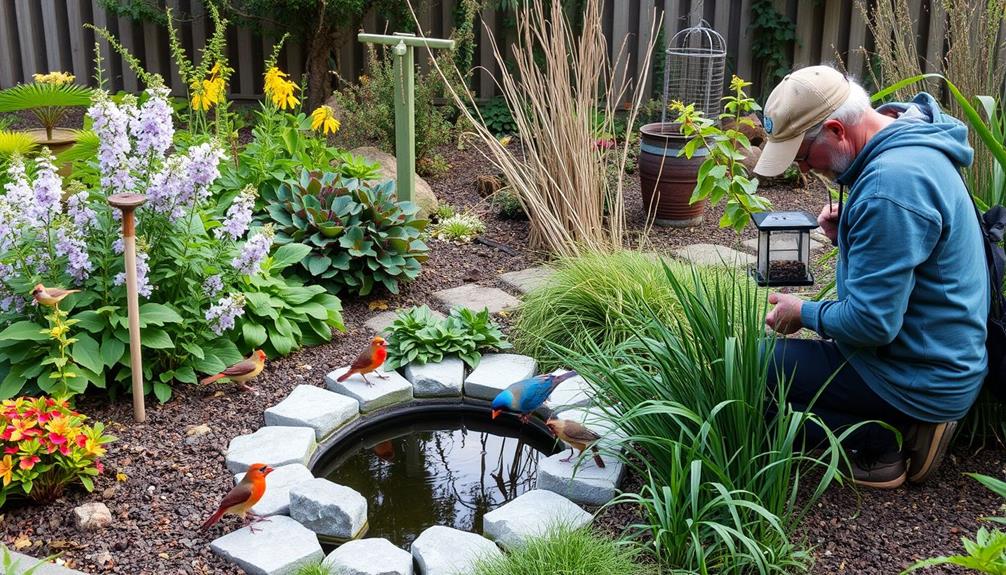
To create a thriving backyard bird sanctuary, you need to identify invasive species that threaten your native plants.
Employing effective removal strategies and techniques can restore balance and improve habitats for birds.
Identifying Invasive Species
In your quest to create a thriving backyard bird sanctuary, identifying invasive species is a vital step. Invasive plants, like Phragmites australis, can block sunlight and nutrients that native plants need to flourish, ultimately harming local ecosystems and the birds that depend on them.
By recognizing and removing invasive species, you can restore natural habitats and guarantee that your sanctuary provides the food and shelter birds require.
Here are some tips to help you identify invasive species in your backyard:
- Learn to recognize common invasive plants in your area.
- Monitor your garden regularly for any signs of invasive growth.
- Research the specific needs of native birds to understand what plants they rely on.
- Engage with local conservation groups for resources and advice on managing invasive species.
- Document changes in your garden to track the impact of removing invasive plants.
Removal Strategies and Techniques
While managing invasive species in your backyard sanctuary might seem intimidating, implementing effective removal strategies can greatly enhance the health of your ecosystem.
Start by identifying invasive plants in your area, like Phragmites australis, which can block sunlight and nutrients, harming native plants and bird habitats. Once you've identified them, focus on removing invasive species using manual techniques such as hand-pulling or digging for small infestations. This not only prevents their spread but also promotes native biodiversity.
Establish a regular monitoring schedule to assess the effectiveness of your removal efforts. This will help you catch any re-establishment of invasive species before they take hold again.
If manual removal isn't sufficient, you might consider organic herbicides as a last resort. Just make sure they're safe for birds and other wildlife to minimize ecological disruption.
Ensuring Safe Nesting Areas
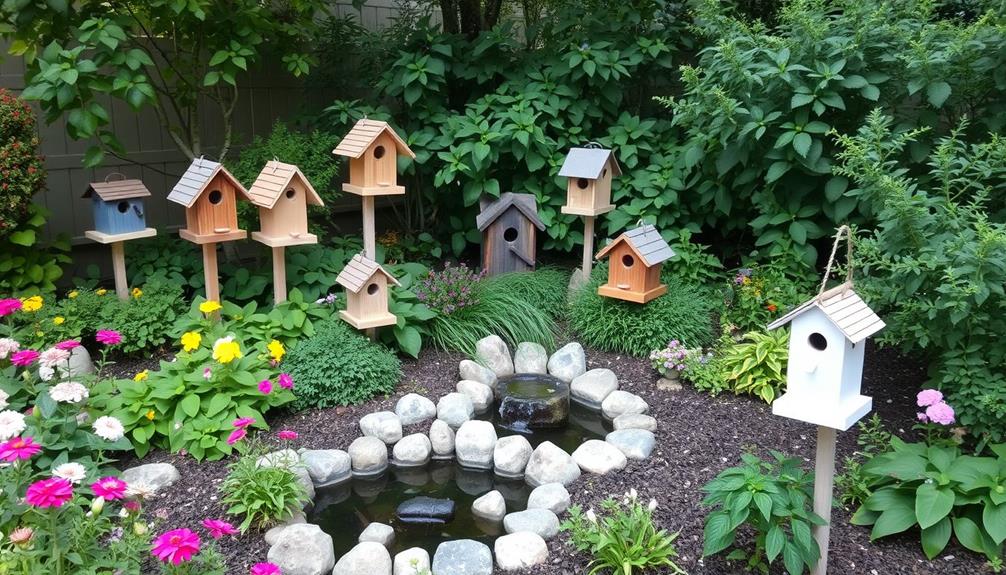
Creating a safe nesting area is essential for attracting birds to your backyard sanctuary. To guarantee your sanctuary provides a safe space for birds, consider the following tips when setting up nesting boxes:
- Choose birdhouses designed for specific local species, with proper ventilation and predator resistance.
- Install nesting boxes at least 5-10 feet above ground, away from potential threats like cats and raccoons.
- Use untreated wood for your birdhouses to create a chemical-free environment that aids in insulation.
- Maintain a distance of at least three feet between bird feeders and nesting boxes to reduce stress on nesting birds.
- Regularly clean and inspect birdhouses after the nesting season to keep them safe and suitable for future occupants.
Engaging the Community
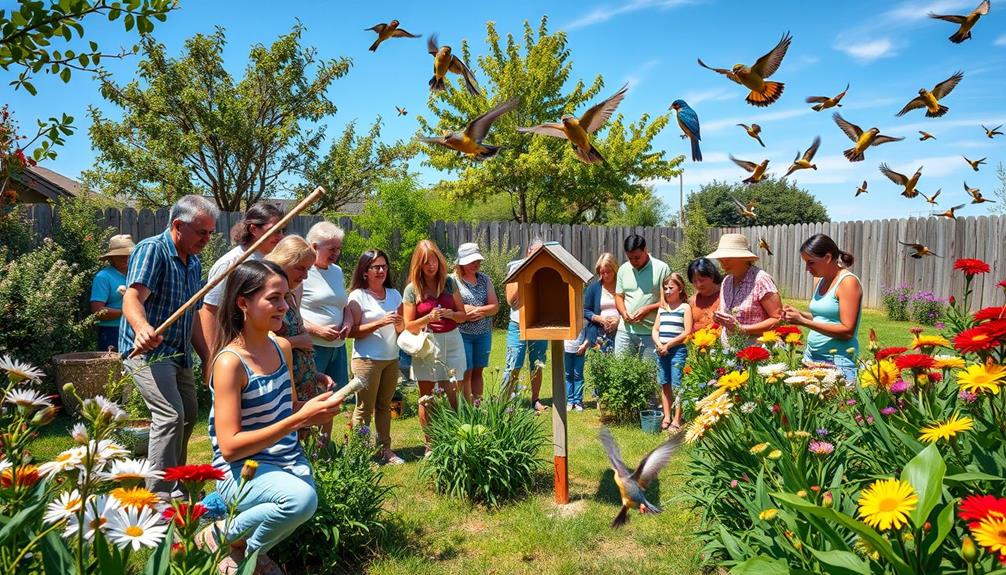
Attracting birds to your backyard sanctuary isn't just about providing safe nesting areas; it's also about fostering a community that values and protects these feathered friends. Engaging the community is key to enhancing local conservation efforts and creating a collective responsibility for protecting avian populations.
Start by educating your neighbors on bird-friendly practices. Share resources from local wildlife organizations like the Audubon Society to guide them in creating their own bird sanctuaries. Hosting community events like birdwatching tours or workshops can raise awareness and encourage participation in backyard wildlife conservation initiatives. These gatherings let everyone connect over a shared passion for birds and nature.
Don't overlook the power of collaboration with local schools. By incorporating bird conservation topics into their educational programs, you can inspire the next generation to appreciate and protect local wildlife.
Additionally, consider organizing local clean-up days to remove invasive species from parks and gardens. This not only improves habitats for birds but also boosts community involvement in conservation efforts.
Promoting Bird Conservation Practices
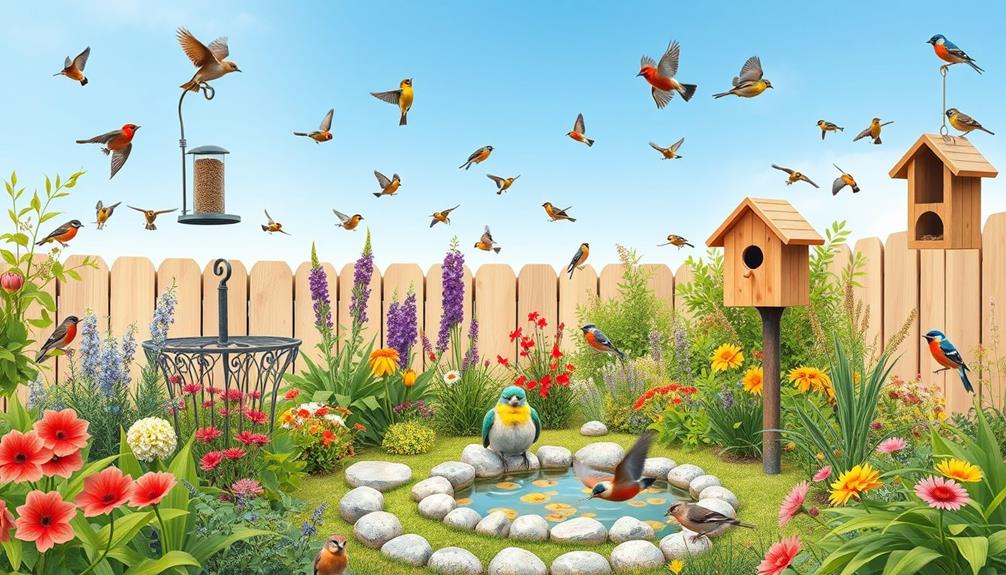
To effectively promote bird conservation practices, start by educating yourself and your community about the importance of preserving local wildlife habitats.
Healthy habitats support diverse bird populations, so your efforts can make a significant impact. Engage your neighbors in activities like the Great Backyard Bird Count to build community involvement and awareness of local bird species and their conservation needs.
Here are some effective ways to promote bird conservation:
- Implement organic pest control to minimize harm to birds.
- Maintain clean feeders to provide food and shelter for visiting birds.
- Collaborate with local wildlife organizations for resources and guidance.
- Encourage window safety measures, such as decals, to reduce bird collisions.
- Share knowledge about the benefits of native plants in attracting birds.
Frequently Asked Questions
How to Create a Bird Sanctuary in Your Backyard?
To create a bird sanctuary in your backyard, choose native plants, set up feeders with suitable food, provide fresh water, remove invasive species, and design diverse habitats. This'll attract and support a variety of birds.
What Makes a Place a Bird Sanctuary?
A place becomes a bird sanctuary when it offers food, water, and shelter. You'll need native plants, clean feeders, and diverse habitats to attract various species, ensuring a safe environment for birds to thrive.
How to Make Bird Paradise in the Backyard?
To create a bird paradise in your backyard, plant native flora, set up diverse feeders, provide fresh water, and design varied habitats. Regularly clean feeders and baths, ensuring a welcoming environment for your feathered friends.
How Do You Make an Outdoor Bird Shelter?
To make an outdoor bird shelter, choose a suitable design, use untreated wood, and position it 5-10 feet off the ground. Add ventilation holes, and remember to clean it regularly for healthy nesting.
Conclusion
Creating a backyard bird sanctuary is like planting a seed; with care and attention, it can blossom into a vibrant refuge for our feathered friends. By researching local species, selecting suitable plants, and providing food and water, you'll cultivate an inviting habitat. As you engage with your community and promote conservation, you'll not only enrich your own life but also contribute to the health of our ecosystem. Together, let's nurture nature and watch it thrive!
